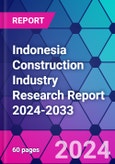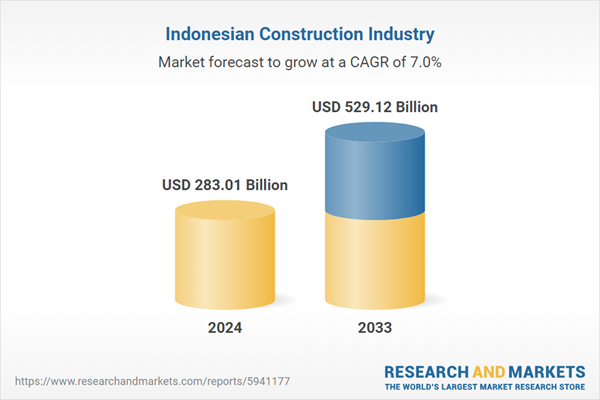According to the publisher's analysis, the market size of Indonesia's construction industry increased year by year until 2019, from IDR 1,041.95 trillion in 2014 to IDR 1,701.74 trillion in 2019. From 2020, due to the impact of embargoes, supply chain disruptions, and labor shortages from the epidemic, the GDP of Indonesia's construction industry will decline. Later, due to the boost from urbanization and infrastructure, the GDP of Indonesia's construction sector increased in 2022.
In 2023, the Indonesia construction market size is estimated at USD 264 billion. According to the publisher's forecast, the Indonesia construction market size is estimated at USD 283 billion in 2024 and is expected to reach USD 529.1 billion in 2033, growing at a CAGR of 7.2% from 2024 to 2023.
Remote collaboration tools, virtual meetings, and digital project management platforms are now key to project coordination. The shift to non-contact construction methods and the increasing use of automation and robotics are likely to be popular in the construction industry in the future. Indonesia's construction industry will also shift towards intelligence and digitalization in the future.
Overall, the state of Indonesia's construction sector remains sound with a strong growth outlook anchored by low inflation, political stability and prudent macroeconomic policies. What remains is to gain a proper understanding of the market and its various niches.
Indonesia, with a population of approximately 280 million people, is the largest economy in Southeast Asia and is expected to continue to grow in the coming years, favorably boosting the construction industry.
Topics covered:
- Indonesia Construction Industry Overview
- The economic and policy environment of the construction industry in Indonesia
- Indonesia construction industry market size, 2024-2033
- Analysis of major Indonesia construction industry manufacturers
- Key Drivers and Market Opportunities in Indonesia's Construction Industry
- What are the key drivers, challenges and opportunities for the construction industry in Indonesia during the forecast period 2024-2033?
- Which companies are the key players in the Indonesia construction industry market and what are their competitive advantages?
- What is the expected revenue of Indonesia construction industry market during the forecast period of 2024-2033?
- What are the strategies adopted by the key players in the market to increase their market share in the industry?
- Which segment of the Indonesia construction industry market is expected to dominate the market in 2032?
- What are the main negative factors facing the construction industry in Indonesia?
Table of Contents
Companies Mentioned
- PT Wijaya Karya
- PT ADHI KARYA (Persero) Tbk.
- PT Pembangunan Perumahan (PP)
- PT Hutama Karya
- PT Acset Indonusa
- PT Jaya Konstruksi Manggala Pratama
- PT Waskita Karya (Persero) Tbk
- PT Jasa Marga (Persero) Tbk
- PT Totalindo Eka Persada (Totalindo)
- PT PP Presisi Tbk
Methodology
Background research defines the range of products and industries, which proposes the key points of the research. Proper classification will help clients understand the industry and products in the report.
Secondhand material research is a necessary way to push the project into fast progress. The analyst always chooses the data source carefully. Most secondhand data they quote is sourced from an authority in a specific industry or public data source from governments, industrial associations, etc. For some new or niche fields, they also "double-check" data sources and logics before they show them to clients.
Primary research is the key to solve questions, which largely influence the research outputs. The analyst may use methods like mathematics, logical reasoning, scenario thinking, to confirm key data and make the data credible.
The data model is an important analysis method. Calculating through data models with different factors weights can guarantee the outputs objective.
The analyst optimizes the following methods and steps in executing research projects and also forms many special information gathering and processing methods.
1. Analyze the life cycle of the industry to understand the development phase and space.
2. Grasp the key indexes evaluating the market to position clients in the market and formulate development plans
3. Economic, political, social and cultural factors
4. Competitors like a mirror that reflects the overall market and also market differences.
5. Inside and outside the industry, upstream and downstream of the industry chain, show inner competitions
6. Proper estimation of the future is good guidance for strategic planning.

LOADING...
Table Information
| Report Attribute | Details |
|---|---|
| No. of Pages | 60 |
| Published | February 2024 |
| Forecast Period | 2024 - 2033 |
| Estimated Market Value ( USD | $ 283.01 Billion |
| Forecasted Market Value ( USD | $ 529.12 Billion |
| Compound Annual Growth Rate | 7.0% |
| Regions Covered | Indonesia |
| No. of Companies Mentioned | 10 |









